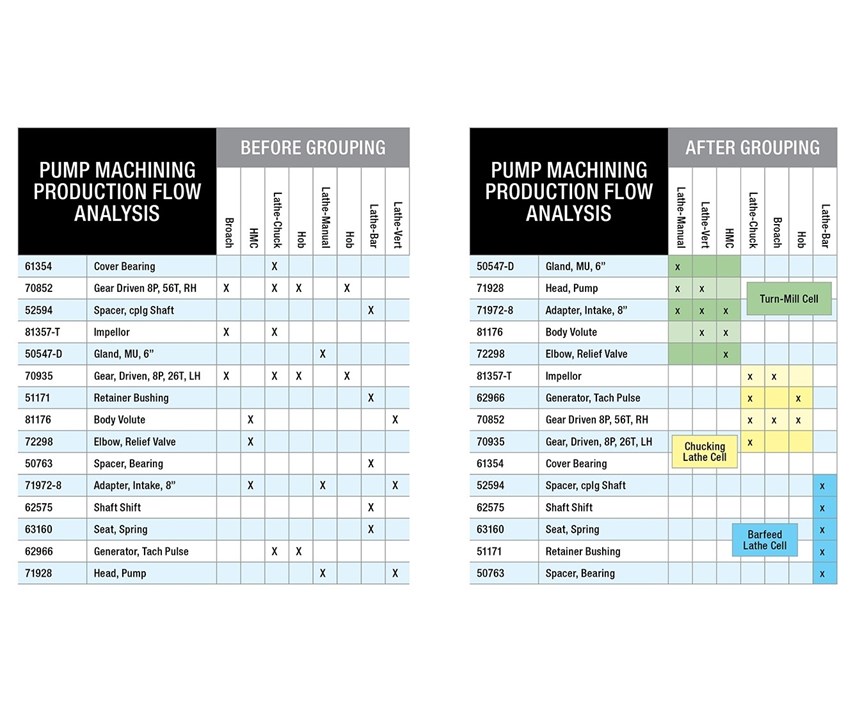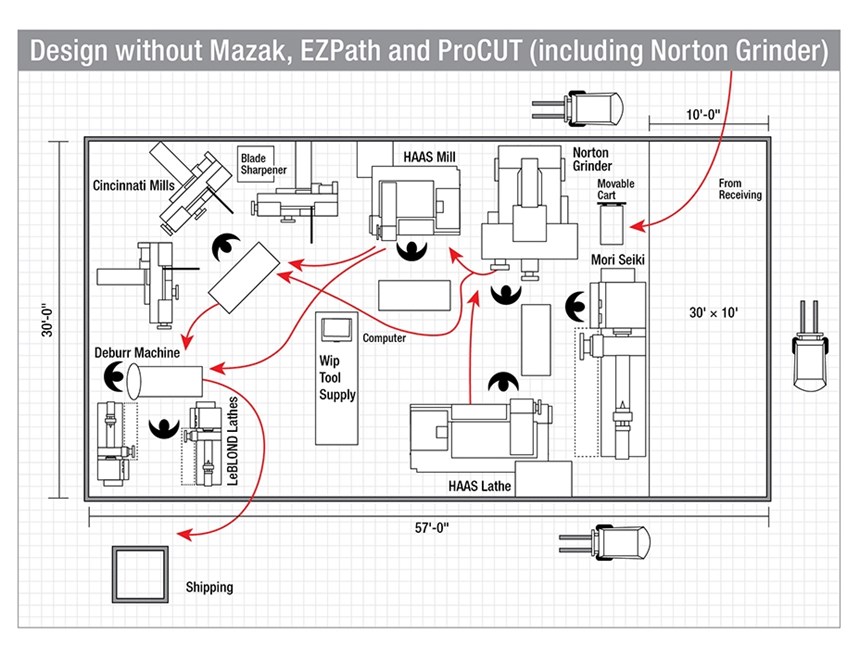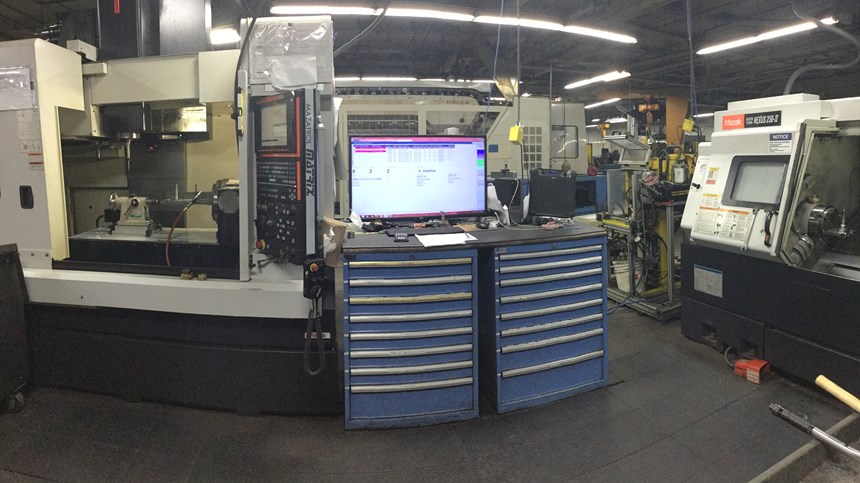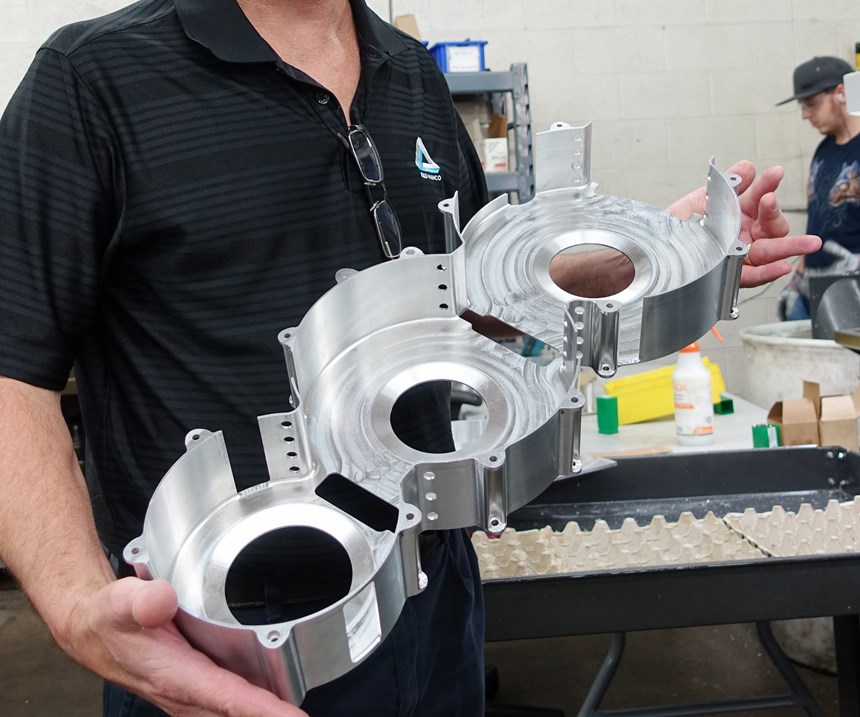10 Lean Manufacturing Ideas for Machine Shops
In addition to the right mix of traditional strategies, a lean manufacturing toolkit can make high-mix, low-volume machining faster, more predictable and less expensive.
Share




Lean manufacturing as it is traditionally practiced is of benefit to machine shops, but the extent of its benefit is often limited. The Toyota Production System on which lean manufacturing is based was designed for assembly plants that produce automobiles by the thousands. While an assembly plant focuses on low-mix, high-volume production, a typical machine shop focuses on high-mix low-volume production. A machine shop and assembly plant cannot expect to realize the same lean benefits with the same lean tools.
What tools are those? Today, many machine shops have realized the gains from implementing one or more of the methods listed in the “Lean Tools to Use” list below. In contrast, the lean tools in the “Lean Tools to Avoid” list are ineffective or inapplicable in a machine shop. They cannot handle the complexity of a high-mix low-volume shop, especially if it is a job shop!
Lean Tools to Use |
Lean Tools to Avoid |
|
|
Here are some of the new tools that belong in the machine shop’s lean manufacturing toolkit:
Segment the Product Mix
Most machine shops choose to make a diverse range of products that differ in their respective annual production volume, demand pattern and margin. Based on these three business attributes, divide the products into two segments: Runners/Repeaters and Strangers.
For parts in the Runners/Repeaters segment, batch sizes will tend to be medium or large with many parts having long-term agreements. In contrast, for parts in the Strangers segment, batch sizes will trend small. These orders tend to be one-offs, repairs, prototypes, or start- or end-of-lifecycle jobs. Different order fulfillment strategies, rules for CRM (customer relationship management), business practices and so on need to be used for either of these two segments. A job shop can think of itself like a hospital wherein the Emergency Department operates as a separate “mini-hospital” within the main facility for rapid care delivery. Ideally, the average lead time to deliver care to any given patient is short.
Rationalize the Product Mix Annually
At the end of each year, eliminate the “cats and dogs”—those products that are losing money. As a machine shop manager quipped to me years ago, “We are happy to send our difficult parts, and sometimes our difficult customers, too, to our competitors. It does not hurt our business if their production efficiencies and profit margins are affected!”
Split One Machine Shop into Two
In Shop 1, produce orders for parts or products that are in the Runners/Repeaters segment of the product mix. In Shop 2, produce orders for parts or products that are in the Strangers segment of the product mix. Set up Shop 2 to operate as a quick-turnaround shop with resources such as additive manufacturing, flexible automation, multitasking machines and machining centers with pallet-changers that can produce any part in a single setup, no matter how small the quantity. Even the skill levels of the employees in the two shops will be different. Employees in Shop 1 will tend to prefer production runs of mature parts, whereas employees in Shop 2 will prefer the challenges of manufacturing complex one-offs and mastering new technology.
If the Shop Currently Uses a Process Layout, Change It
In a process layout, similar machines are co-located in functional departments (manual lathes, CNC lathes, manual mills, CNC mills and so on). Any machine shop that has a process layout will always operate in a batch-and-queue production mode.
Implement a Cellular Layout in Shop 1
First, identify the product families in the Runners/Repeaters segment of the shop’s product mix. From the ERP system, extract the routings of all the parts or products to create the initial Product-Process Matrix. An example is shown in Figure 1. Next, use any commercially available data analysis package (like Minitab, JMP or R) to manipulate this matrix to get the final Product-Process Matrix. In this latter matrix, each family of parts whose routings contain the same (or similar) machines indicates the group of machines that should be co-located as a manufacturing cell to produce those parts.
Co-location of all the machines, personnel and support services relevant to a given set of parts streamlines and simplifies material flows. If a cell is implemented with management’s support, it will probably be apt to have manufacturing focus; operational flexibility; a culture of continuous improvement through teamwork; performance metrics that do not promote individualistic or elitist behavior; and a sense of ownership and autonomy for its members.
Right-Size Non-Machining Processes
CNC machine tools alone do not determine a machine shop’s delivery performance and profitability. Manual processes such as sawing and inspection, and non-machining processes such as heat treatment, electroplating, coating and washing are often root causes for long delivery times.
Right-sizing a process that is currently external to a cell, such as washing, painting, deburring or inspection, can allow it to be brought into the cell. This can have a significant impact on quality, delivery time and work in process. This shift also can improve morale and job satisfaction for the cell personnel, because the team’s performance will not be affected by the workmanship and schedule priorities of others, including those who work in both other cells and external departments that serve all cells.
There are limitations to this idea. Processes like heat treatment or electro-plating could hardly ever be co-located with CNC machines. Inspection is often the real bottleneck, but this problem is not necessarily easy to address. When will the day come when inspection in a shop can be right-sized and the inspection department eliminated?
Purchase a Multifunction Machine Tool
Metal removal rates generally remain the chief driver of a machine shop’s capital investment choices. Unfortunately, the mindset of “keep making chips” can result in the purchase of machines that 1) do not alleviate the shop’s capacity constraints, 2) do not increase throughput at bottlenecks, 3) waste payroll to keep employees busy producing WIP, and 4) do not reduce the total distance that the typical order must travel through the shop.
Instead of fixating on metal removal rates and machine utilization, machine shops should look to multifunction machines and systems that combine consecutive operations currently being done on different machines, especially if those machines are currently located in separate departments. The shop could first do a Product-Process Matrix analysis of its product mix to find part families. For a particular part family, the shop can then compute workloads on the different machines in that cell, identifying a set of two or three machines performing consecutive operations that appear in the routings of most parts in the family. For all those operations that would have to be done on a single machine, the shop then prepares the list of specifications—work envelope, axes, number of tools, in-process gaging and so on—and presents that list of specifications to machine tool vendors that could build the multifunction machine or system.
Standardize Routings within Part Families
Every effort should be made to critique and re-engineer the routings of all parts that have been grouped into a family based on their similar routings. First, the routings should be standardized by eliminating the differences in the machines used and the sequences in which the machines are used. Next, the routings should be standardized by eliminating the differences in the fixtures, tools and gages used. The ideal for any shop is material flowing in linear, assembly-line fashion from one end of the facility to the other as depicted in Figure 2, a stark contrast to the common spaghetti diagram.
Move from Make-To-Stock to Make-To-Order Scheduling
A machine shop typically executes a different schedule every day. Each day’s schedule could include jobs with a different mix of due dates, lot sizes, number of operations and setup run times. Regardless of all these differences, it is important that the shop’s daily schedule loads all work centers with jobs with a workload that does not exceed available capacity constraints on key resources such as machines, labor and materials.
A machine shop should not expect its ERP (enterprise resource planning) system to achieve this goal. The typical ERP system uses an MRP (material requirements planning) or MRP-II (manufacturing resources planning) engine to plan production and schedule operations. MRP assumes infinite capacity, fixed lead times and batch production to reduce setup times. An alternative to relying on an ERP system is to use finite capacity schedulers (FCSs) that employ either the Drum-Buffer-Rope method of scheduling (DBR+, InforVisual EasyLean) or advanced dispatching heuristics and user-defined rules (Preactor, Tactic, Schedlyzer).
However, in the case of a manufacturing cell, there may not even be a need for scheduling software. Ideally, a cell contains all equipment needed to produce any part in the cell’s part family (except vendor operations or true monuments such as heat treat). At the daily morning huddle, the cell’s team could meet with the production controller. They could eyeball the jobs in process or in queue from the previous day and determine whether the cell could process any new jobs if they were released that day. A cell guarantees start-to-finish control of the flow of its orders within a small area of the shop. So, except for unforeseen emergencies, the cell team members can execute as a team to easily ensure on-time completion of all jobs by their due dates. Never underestimate the do-or-die determination of a cell’s team to deliver customer service by completing orders at the right time with the right quality at (or below) cost!
Use “Water Spiders” to Manage Shop-Floor Logistics
Let’s assume that after its ERP system is integrated with a commercial FCS, a machine shop can generate a feasible daily schedule, both for each cell and for external monuments that are shared by the cells and support departments (Receiving, Shipping, Inspection, etc.). Next, the shop must release that schedule to the floor, execute it and, at the end of each shift, publish the current status of all active jobs to the ERP system. The role of schedule execution and status updating in the ERP system is fulfilled by a manufacturing execution system (MES). There is merit in implementing a fully integrated system comprising an ERP, FCS and MES if the facility is large. However, in the case of a single-location, high-mix, low-volume machine shop, especially a small family-owned job shop, it may not be advisable to immediately purchase an MES to complement the FCS that took over scheduling from the ERP system. Instead, I advise these smaller machine shops to create the position of “water spider” by freeing up one or more employees on the current payroll.
This job combines the work that is typically done by a material handler (who reports to the plant manager) and an expeditor (who reports to the production controller). Specifically, the water spider handles the logistics of moving raw materials, in-process batches and finished parts among workstations as specified in the routers of the different parts. By virtue of being all over the shop floor, the water spider has both the situational awareness and the authority needed to execute, monitor and update the daily schedule that was released to the floor.
In a recent implementation project at one shop (see Modern Machine Shop’s July 2017 article, “Lean Comes Alive”), two water spiders eliminated the previous practice where every employee (including the skilled CNC machinists) was responsible for moving the pair of finished parts to the next workstation. This machine shop realized significant savings after consolidating non-value-added walking time into the work done by just the two water spiders.
A lean machine shop should not stop with implementing only those tools commonly associated with lean. Other approaches can help to extend the lean journey and avoid leaving benefits on the table.
Read Next
Building Out a Foundation for Student Machinists
Autodesk and Haas have teamed up to produce an introductory course for students that covers the basics of CAD, CAM and CNC while providing them with a portfolio part.
Read More5 Rules of Thumb for Buying CNC Machine Tools
Use these tips to carefully plan your machine tool purchases and to avoid regretting your decision later.
Read MoreSetting Up the Building Blocks for a Digital Factory
Woodward Inc. spent over a year developing an API to connect machines to its digital factory. Caron Engineering’s MiConnect has cut most of this process while also granting the shop greater access to machine information.
Read More































